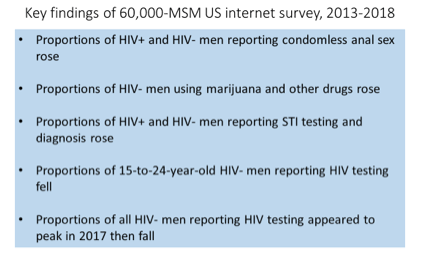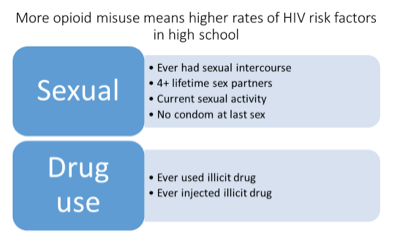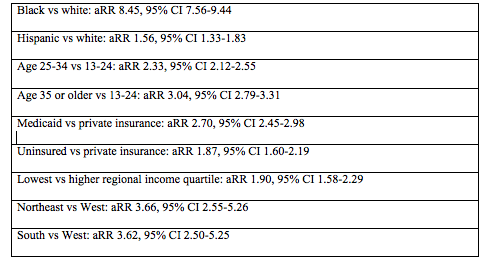 |
 |
 |
| |
HIV risk in MSM, transgender people,
high-school students, new mothers
|
| |
| |
2019 National HIV Prevention Conference, March 18-21, 2019, Atlanta
Mark Mascolini
Over the past several years, HIV-negative and positive US men who have sex with men (MSM) reported increasing condomless anal sex, illicit substance use, and sexually transmitted infections, according to results of a 60,000-man internet survey [1]. Analysis of 230 million responses from the US Behavioral Risk Factor Surveillance System linked high-risk sex behavior to three signals of limited healthcare access [2].
Other work presented at the 2019 National HIV Prevention Conference identified STI-related and demographic factors that predict HIV acquisition [3], linked nonmedical opioid use to HIV risk behaviors in high-school students [4], and tied race/ethnicity, Medicaid, and low income to higher chances of HIV infection in US women delivering an infant [5].
Risk behaviors, HIV testing rising among MSM in big US internet survey
HIV risk behaviors including condomless anal sex, substance use, and STI diagnoses climbed among HIV-negative and positive MSM in a 60,000-man 2013-2018 internet-based US study [1]. HIV testing rates rose across most study years, but fell among MSM 15 to 24 years old.
Emory University researchers who conducted this study argued that technology-based surveillance strategies--such as those analyzing internet or smart phone samples--can gather data from large geographic areas more easily than standard in-person surveys. To exploit widespread internet use by US MSM, they plumbed data amassed over the past 6 years in the American Men's Internet Survey (AMIS), which collects more than 10,000 annual surveys on HIV risk behavior in MSM 15 years old or older in all US states.
This analysis included cis-male US residents who ever reported sex with another man. Participants answered questions on sexual behavior, testing behavior, substance use, STI diagnoses, and HIV status (positive or negative/unknown). The researchers applied Poisson models using generalized estimating equations to test for linear trends over the years 2013-2018. Models adjusted for age, race/ethnicity, recruitment source, and county population density.
The study population included 60,032 MSM--about 10,000 men from each of the 6 study years. Most participants (72%) were white, while 14% were Hispanic, 6% black, and the rest other or mixed races. The largest proportion of men (43%) was 40 or older, 16% were 30 to 39, 14% were 25 to 29, and 26% were 15 to 24. Proportions of MSM in each region were 38% in the South, 23% in the West, 20% in the Midwest, and 18% in the Northeast. One in 10 men reported having HIV infection.
Across the 6 study years, proportions of men reporting condomless anal sex rose significantly in both men with HIV and HIV-negative/unknown men (P < 0.0001 for both). But 2013-to-2018 rates were higher in men with HIV (about 70% in 2013 to 80% in 2018) than in negative/unknown men (about 60% to 70%). Rates of HIV-discordant condomless anal sex also rose significantly in the HIV group and the non-HIV group (P < 0.0001), and again proportions reporting such sex were higher in the HIV group (about 40% in 2013 to 52% in 2018).

MSM with and without HIV reported significantly rising use of marijuana, with a bigger upswing among negative/unknown men (about 23% to 32% across study years, P < 0.0001) than among HIV-positive men (about 28% to 30%, P = 0.0113). Proportions of men reporting use of other drugs (most often poppers, cocaine, and painkillers) rose significantly among negative/unknown men (from about 16% in 2013 to 20% in 2018, P < 0.0001), while staying flat, though at a higher level, in men with HIV (about 30%, P = 0.0647).
From 2013 through 2018, proportions of participants reporting STI testing and STI diagnoses rose significantly in both HIV-positive and negative/unknown men (P < 0.0001 for all four increases). Over the 6 study years, proportions reporting STI testing rose from about 60% to 70% among men with HIV and from about 30% to 40% in HIV-negative/unknown men. In 2018 proportions reporting an STI diagnosis stood at about 20% in the HIV group and 10% in the negative/unknown group.
Among HIV negative/unknown men, the proportion reporting recent HIV testing climbed from about 50% in 2013 to about 60% in 2017, then waned to a little over 50% in 2018, but the overall trend was statistically significant (P < 0.0001). Proportions of 15-to-24-year-old men reporting recent HIV testing fell significantly across the study years, from about 48% to 40% (P < 0.0001). Proportions reporting HIV testing rose significantly across the 6 study years in the three other age groups (25-29, 30-39, 40+) (P < 0.0001 for all three groups). But HIV testing peaked in 2017 in the 25-29 group and the 30-39 group, then fell in 2018.
The Emory team underlined both positives and negatives in their findings. On the plus side, they found it encouraging that HIV-negative/unknown MSM nationwide reported increasing HIV and STI testing over the 2013-2018 study period. But on the minus side, they stressed signals of increasing risk in MSM with and without HIV: more condom-free anal sex, more substance use, and more STI diagnoses (which could at least partly reflect rising STI testing). "Interventions to improve condom use and decrease substance use are either not working," the research team concluded, "or are not reaching adequate numbers of MSM in all US regions."
High-risk sex predicts healthcare constraints in 230-million US sample
People who reported high-risk sexual behaviors in the past year had higher odds of lacking insurance or a provider and not seeing a provider because of cost, according to a 230-million person analysis in the United States [2].
CDC researchers who conducted this study noted that barriers to healthcare persist despite wider insurance access with the Affordable Care Act (Obamacare). Access to routine screening and treatment for HIV and other sexually transmitted infections (STIs) is critical for all, they observed, but especially for people who have risky sex.
To explore potential relations between high-risk sexual behavior (HRSB) and access to health services, they examined data from the most recent (2016) Behavioral Risk Factor Surveillance System. For this analysis HRSB included multiple sex partners, previous STI diagnosis, condomless anal sex, intravenous drug use, and paying for sex--all in the past year. The researchers used adjusted logistic regression models to assess the impact of HRSB on measures of healthcare access.
The total weighted US sample included 230 million respondents, of whom 6.2% reported HRSB in the past year (95% confidence interval [CI] 6.0-6.3). Compared with people who did not report recent HRSB, those who did proved more likely to:

Logistic regression adjusted for age, sex, and race determined that HRSB in the past year independently predicted three access barriers at the following adjusted odds ratios (aOR) and 95% CI:

The researchers reminded colleagues that these three indicators of decreased access to care "can lead to increased morbidity, increased duration of infection, and the potential for increased HIV and [STI] transmission for those infected with [STIs]."
More STIs, male or transgender sex predict HIV within 2 years of STI
Three variables independently predicted HIV acquisition within 2 years of a sexually transmitted infection (STI) in a large Washington, DC study: number of STI infections or repeat infections, male gender, and transgender status [3]. Most new HIV infections occurred within 1 year of the most recent STI.
Collaborators from the DC Department of Health and George Washington University noted that plentiful evidence points to STIs as a major risk factor for subsequent HIV infection. Because little is known about the timing of this association or HIV risk predictors after an STI, they mounted this analysis of STI and HIV surveillance data from the DC Department of Health.
STIs of interest had to occur in 2015-2016 and new HIV infections from 2015 through 2018. The researchers matched STI cases to newly diagnosed HIV cases with a 2-step method: (1) an 11-key SAS algorithm using combinations of name and date of birth and (2) probabilistic matching using Link Plus. They observed individuals for 2 years after their last reported STI; they excluded HIV diagnoses that occurred within 30 days of the first STI.
This process yielded 16,200 STIs in the observation period, including 131 (0.8%) followed within 2 years by HIV and 16,069 STIs not followed by HIV. Median time from STI to HIV diagnosis stood at 45 weeks. Of the 131 people who acquired HIV within 2 years of an STI, 75 (57%) had HIV within 1 year of their STI.
Incidence density analysis of potential HIV predictors within 2 years of an STI established the highest incidence density in three groups: men who have sex with men and women, men who have sex with men, and transgender persons.
Analysis adjusted for age, gender, number of STIs, and STI anatomic location identified three independent predictors of HIV acquisition within 2 years of an STI at the following adjusted odds ratios (aOR) (and 95% confidence intervals):

Variables not associated with HIV acquisition in this analysis were age and STI site (genital, rectal, or oropharyngeal).
The DC investigators recommended that health departments "partner with clinicians and community health organizations to provide intensive prevention (PrEP or PEP) for persons with multiple STIs and possibly men and transgender persons." They suggested the possibility of identifying and prospectively tracking a cohort of high-risk HIV-negative people with multiple STIs.
Opioid misuse by US teens tied to sexual risk, other illicit drug use
Analysis of 14,765 US high-school students linked more nonmedical use of prescription opioids to higher rates of sexual risk behaviors and use of other illicit drugs [4]. But youngsters who misused opioids proved more likely to have an HIV test.
CDC researchers noted that US deaths from opioid overdose soared more than 5-fold from 1999 to 2016. And high-school students are part of this epidemic. The 2017 national Youth Risk Behavior Survey (YRBS) determined that 14% of high-school students reported lifetime opioid misuse. Using the nationally representative YRBS sample, a CDC team set out to determine whether lifetime opioid misuse affects rates of HIV risk behaviors, illicit drug use, and HIV testing in US high-school students. They also wanted to learn whether a dose-response relationship governs the impact of opioid misuse on risk outcomes, with more misuse tied to greater risk.
Study data came from the 2017 national YRBS, a cross-sectional nationally representative survey of 14,765 students in grades 9 through 12. The survey asked respondents how often they used a prescription pain medicine without a prescription or differently from how their provider instructed. Students could report 0 misuse or misuse 1 or 2 times, 3 to 9 times, 10 to 19 times, 20 to 39 times, or 40 or more times. Risk behaviors were current sexual activity, no condom use during last sex, ever having sex, having 4 or more lifetime sex partners, ever injecting an illegal drug, using other illicit substances, and never being tested for HIV. The investigators used multivariable models to explore the impact of opioid misuse on risk outcomes after adjusting for sex, school grade, race/ethnicity, and sexual identity.
Prevalence of lifetime opioid misuse did not vary significantly by sex or race/ethnicity. But prevalence proved significantly greater in 11th and 12th graders than in 9th graders and in students reporting they were gay, lesbian, bisexual, or unsure of their sexual identity than in heterosexual students.
Nonmedical use of prescription opioids was independently associated with ever having sex (almost 2-fold higher prevalence ratio), 4 or more lifetime sex partners (about 3.5-fold higher), current sexual activity (about 2-fold higher), no condom use during last sex (about 40% higher), ever using illicit drugs (about 6-fold higher), and ever injecting drugs (about 5.7-fold higher). Students reporting opioid misuse were less likely to report never having an HIV test.
Next the researchers compared escalating opioid misuse (1 or 2 times, 3 to 19 times, 20 or more times) with never misusing opioids. Prevalence ratios (PR) rose with each successively higher misuse bracket for all sexual risk behaviors and drug-use behaviors listed in the previous paragraph. (For example, for 4 or more lifetime sex partners, 1 or 2 times, PR 2.00; 3 to 19 times, PR 4.11; 20+ times PR 5.66; for ever using other illicit drugs, 1 or 2 times, PR 4.50; 3 to 19 times, PR 6.47; 20+ times, PR 9.43.)

Source: Clayton H, et al, CDC [4].
The prevalence ratio for not getting an HIV test fell with each successively higher misuse bracket, linking more opioid misuse to lower rates of never having an HIV test (1 or 2 times, PR 0.97; 3 to 19 times, PR 0.92; 20+ times, PR 0.85).
The CDC investigators believe their findings show a link between opioid misuse and HIV risk behaviors in high-school students. They reminded colleagues that behaviors acquired in adolescence are often set for life. And they proposed that youngsters who misuse opioids more frequently "may be an important risk group to target for HIV primary prevention efforts."
US women delivering with HIV more likely poor, uninsured, living in Northeast or South
From 2006 through 2014, HIV-diagnosed US women delivering an infant in the hospital proved more likely to be poor, black or Hispanic, on Medicaid or no insurance, and living in the Northeast or South [5]. Annual rates of HIV diagnoses in delivering women remained stable over the study period.
CDC researchers who conducted this study noted that 2006 was the last year with a national estimate of HIV prevalence in US women delivering an infant. To update that figure and identify factors linked to an HIV diagnosis in delivering women, the CDC team analyzed 2006-2014 data from the National (Nationwide) Inpatient Sample [6]. They used ICD-9 codes and Diagnosis Related Group codes to identify HIV-positive women with a delivery discharge. A generalized linear model assessed independent associations of race/ethnicity, age, insurance, income, and census region with an HIV diagnosis at hospital discharge.
From 2006 through 2014, about 3900 to 4400 women diagnosed with HIV delivered each year. The yearly rate of HIV diagnoses per 10,000 deliveries remained stable from 2006 (10.6, 95% confidence interval [CI] 8.1-13.1) through 2014 (10.3, 95% CI 9.0-11.6). Women who delivered with an HIV diagnosis were more likely to be black or Hispanic, to be 25-34 or 35 or older, to use Medicaid or have no insurance, to live in areas with the lowest income quartile, and to live in the Northeast or South, at the following adjusted relative risks (aRR) and 95% CI:

The CDC investigators called for coordination of providers, case managers, and public health officials to lower chances of mother-to-child HIV transmission among women at higher risk "by offering appropriate medical care before, during, and after delivery and by supporting adherence to antiretroviral treatment among women and infants exposed to HIV infection."
References
1. Sanchez T, Zlotorzynska M, Sullivan P. National and regional trends in sexual, substance use and testing behaviors of men who have sex with men, 2013-2017. 2019 National HIV Prevention Conference, March 18-21, 2019, Atlanta. Abstract 5777.
2. Greenwell K, Coor A, Pearson W. Assessing health care access among those who engage in high-risk sexual behaviors: findings from the Behavioral Risk Factor Surveillance System, 2016. 2019 National HIV Prevention Conference, March 18-21, 2019, Atlanta. Abstract 5473.
3. Dorsey K, Allston A, Castel A. Factors associated with HIV acquisition after a sexually transmitted infection within a 2-year period. 2019 National HIV Prevention Conference, March 18-21, 2019, Atlanta. Abstract 5649.
4. Clayton H, Bohm M, Ashley C, Pampati S, Underwood J. Is there a dose-response relationship between frequency of prescription opioid misuse and HIV risk behaviors and HIV testing? 2019 National HIV Prevention Conference, March 18-21, 2019, Atlanta. Abstract 6127.
5. Aslam M, Owusu-Edusei K, Nesheim S, Gray K, Lampe M, Dietz P. Trends in women with HIV diagnoses at delivery hospitalization in the United States, 2006-2014. 2019 National HIV Prevention Conference, March 18-21, 2019, Atlanta. Abstract 5297.
6. Healthcare Cost and Utilization Project. NIS [National Inpatient Sample] overview. https://www.hcup-us.ahrq.gov/nisoverview.jsp
|
| |
|
 |
 |
|
|